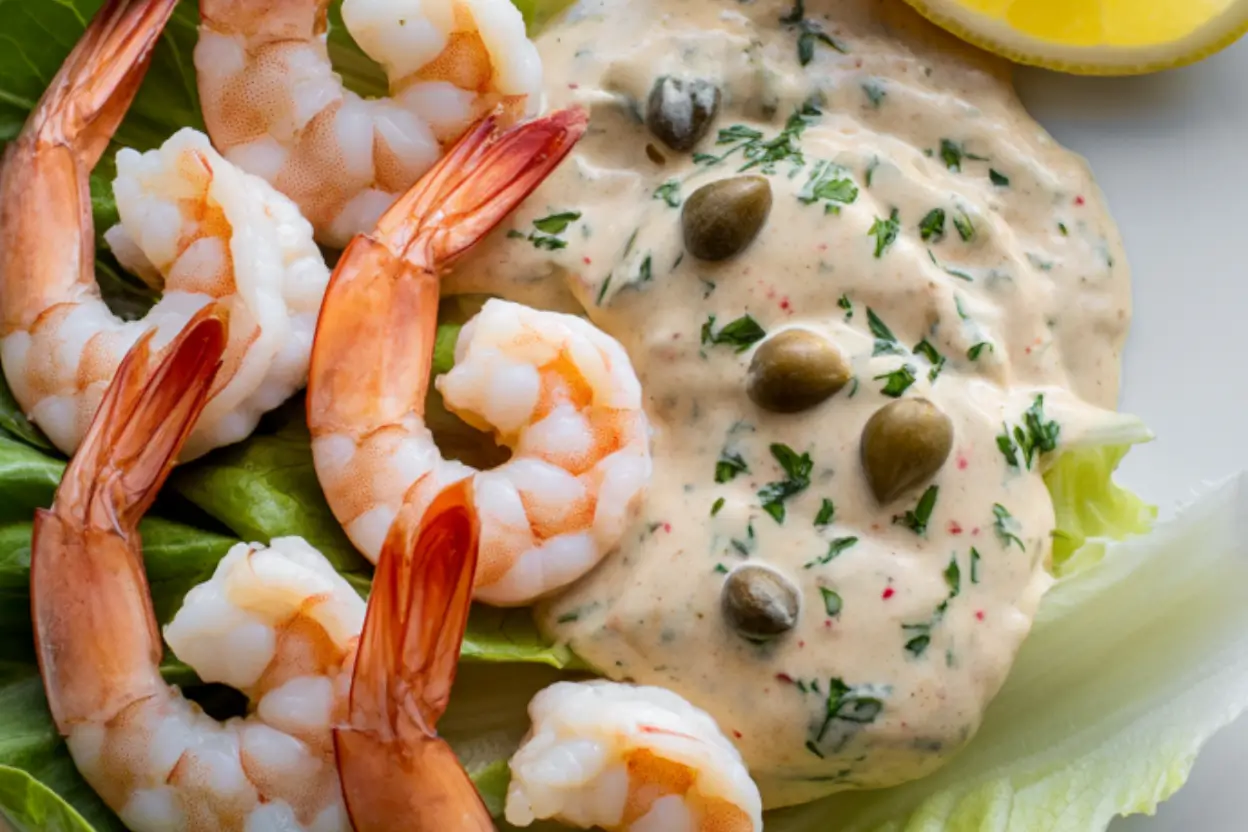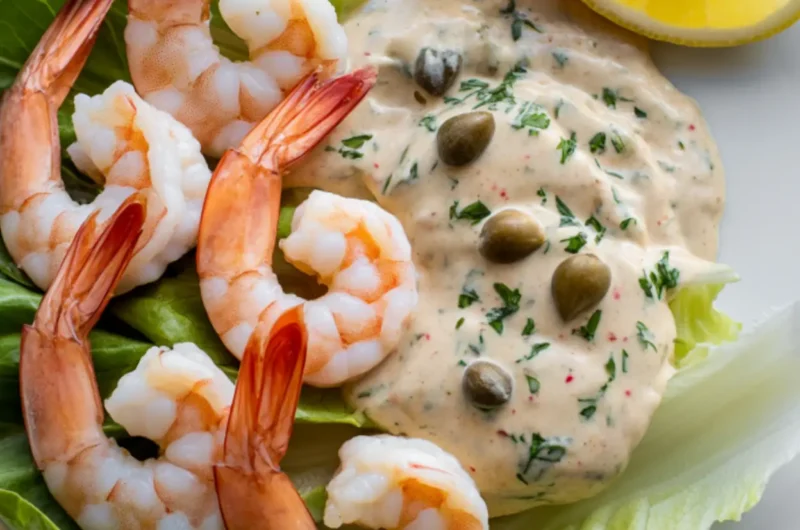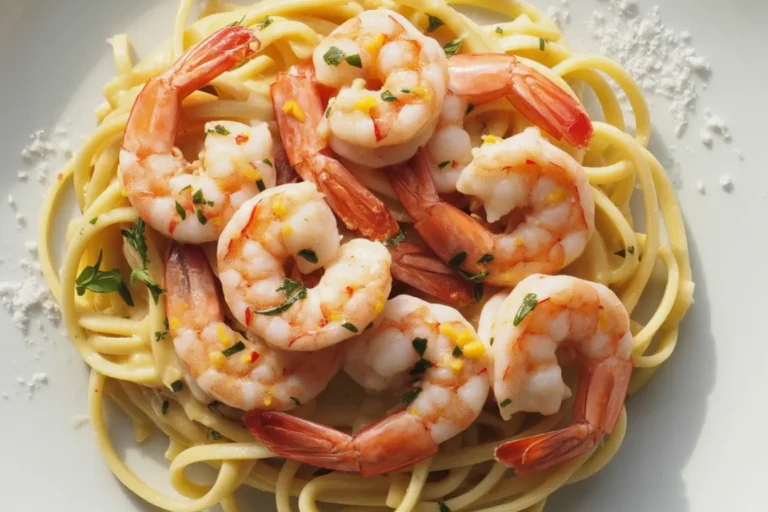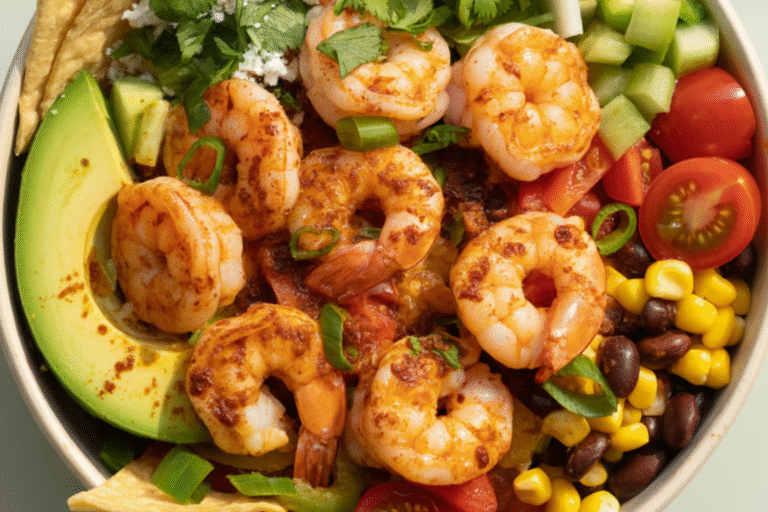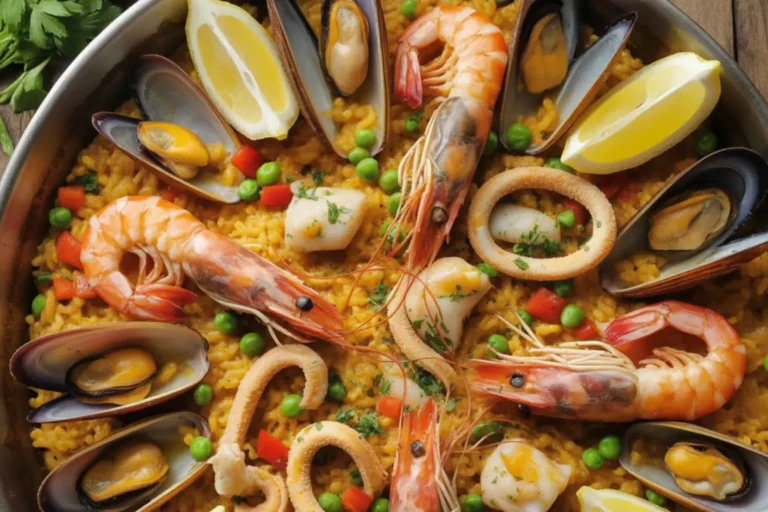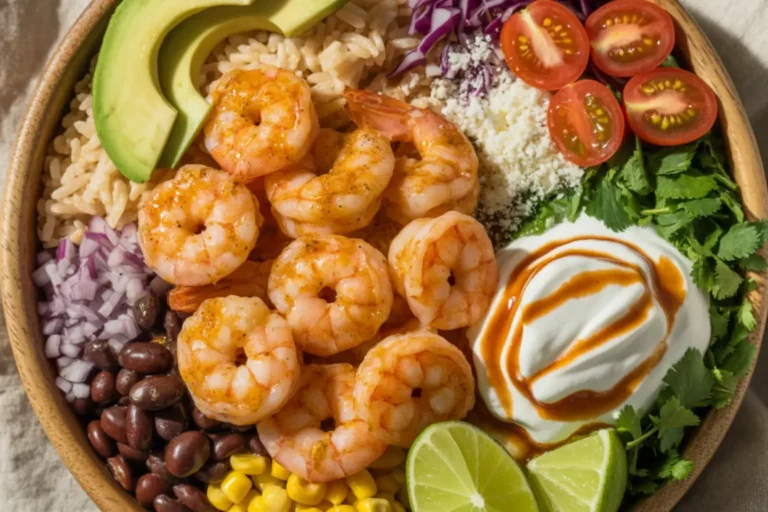Shrimp Remoulade: 5 Steps to a Bold Creole Classic
Table of Contents
There’s something magical about a perfectly executed Shrimp Remoulade. This iconic New Orleans dish strikes the perfect balance between sophisticated and approachable—impressive enough for special occasions yet straightforward enough to master at home. After years of perfecting my technique and studying under some of Louisiana’s most respected chefs, I’m excited to share my definitive guide to creating authentic Shrimp Remoulade that captures the bold, complex flavors of Creole cuisine.
Thank you for reading this post, don't forget to subscribe!Whether you’re planning a dinner party that needs a showstopping appetizer or simply craving a taste of the Big Easy, this recipe delivers restaurant-quality results with remarkably little effort. Let me show you how to create this Gulf Coast classic in just five simple steps that will transport your taste buds straight to the French Quarter.
How to Make Shrimp Remoulade
Quick Overview
Shrimp Remoulade exemplifies everything that makes Creole cuisine so beloved—it’s vibrant, boldly flavored, and deeply satisfying. At its heart, this dish features plump, perfectly cooked shrimp that serve as the ideal vehicle for the star of the show: a zesty, complex remoulade sauce that balances creamy richness with punchy acidity and a subtle kick of heat.
What makes this recipe particularly special is its versatility and approachable elegance. Despite its sophisticated flavor profile, Shrimp Remoulade comes together in under 30 minutes of active preparation time (plus chilling). The remoulade sauce can be prepared days in advance, making this an ideal choice for entertaining when you want to impress without being tied to the kitchen.
The contrast of textures—tender shrimp against crisp lettuce, all bathed in the creamy-yet-tangy sauce—creates a sensory experience that’s far greater than the sum of its parts. Best of all, this dish can serve equally well as an elegant appetizer when plated individually or as a showstopping centerpiece for a buffet. The vibrant colors and bold flavors make it as visually appealing as it is delicious, guaranteeing rave reviews from your guests.
The Ingredients I Use to Bring My Shrimp Remoulade to Life
For the Shrimp:
- 2 pounds large shrimp (21-25 count), peeled and deveined, tails left on
- 2 tablespoons Old Bay seasoning
- 1 tablespoon kosher salt
- 2 lemons, one quartered and one for juice
- 1 yellow onion, quartered
- 3 cloves garlic, smashed
- 2 bay leaves
- 1 tablespoon black peppercorns
For the Creole Remoulade Sauce:
- 1½ cups good-quality mayonnaise
- ¼ cup Creole mustard (substitute whole grain mustard if unavailable)
- 2 tablespoons prepared horseradish
- 2 tablespoons fresh lemon juice
- 2 tablespoons hot sauce (preferably Crystal or Louisiana-style)
- 2 tablespoons ketchup
- 1 tablespoon Worcestershire sauce
- 3 cloves garlic, very finely minced
- 2 tablespoons capers, rinsed, drained and chopped
- 2 tablespoons fresh flat-leaf parsley, finely chopped
- 2 tablespoons green onions, finely chopped (green parts only)
- 1 tablespoon celery, very finely diced
- 1 tablespoon fresh tarragon, finely chopped (or 1 teaspoon dried)
- 1 teaspoon paprika (preferably sweet Hungarian)
- ½ teaspoon cayenne pepper (adjust to taste)
- ½ teaspoon freshly ground black pepper
- ½ teaspoon kosher salt
For Serving:
- 1 head Bibb or Boston lettuce leaves, washed and dried
- 2 tablespoons chopped fresh parsley for garnish
- Lemon wedges
- Optional: cherry tomatoes for garnish
Step-by-Step Instructions
Step 1: Poach the Shrimp to Perfection
- Fill a large pot with approximately 10 cups of water. Add the quartered onion, smashed garlic cloves, quartered lemon, bay leaves, black peppercorns, Old Bay seasoning, and kosher salt.
- Bring the poaching liquid to a rolling boil over high heat, then reduce to a steady simmer and let cook for about 5 minutes to infuse the flavors into the water.
- While the poaching liquid simmers, prepare an ice bath by filling a large bowl with ice and cold water. This will be crucial for stopping the cooking process once the shrimp are done.
- Return the poaching liquid to a full boil, then add the peeled and deveined shrimp all at once. Stir gently to ensure even cooking.
- As soon as the water returns to a boil (usually about 1-2 minutes), remove the pot from the heat. The shrimp should just be turning pink and starting to curl.
- Let the shrimp sit in the hot poaching liquid for exactly 2-3 minutes until they are just cooked through. They should be pink, slightly curled, and opaque.
- Using a slotted spoon or spider strainer, immediately transfer the shrimp to the prepared ice bath to halt the cooking process. This prevents the shrimp from becoming tough and rubbery.
- Once completely cooled (about 5 minutes), drain the shrimp thoroughly and pat dry with paper towels. Proper drying is essential, as excess moisture can dilute the remoulade sauce.
Step 2: Create the Bold Remoulade Sauce
- In a large mixing bowl, combine the mayonnaise, Creole mustard, prepared horseradish, fresh lemon juice, hot sauce, ketchup, and Worcestershire sauce. Whisk until smooth and well incorporated.
- Add the minced garlic, chopped capers, parsley, green onions, celery, and tarragon. Stir to combine.
- Sprinkle in the paprika, cayenne pepper, black pepper, and salt. Mix thoroughly until all ingredients are evenly distributed and the sauce has a consistent color.
- Taste the remoulade and adjust seasonings as needed. For more heat, add additional cayenne; for more acidity, add a bit more lemon juice.
- Cover the bowl with plastic wrap and refrigerate for at least 1 hour (preferably 4 hours or overnight) to allow the flavors to meld and develop. The sauce will improve significantly with time as the flavors marry.
Step 3: Combine the Shrimp and Remoulade
- Remove the remoulade sauce from the refrigerator and give it a good stir to recombine any separated ingredients.
- In a large mixing bowl, add the cooled, dried shrimp and pour about two-thirds of the remoulade sauce over them.
- Using a rubber spatula or large spoon, gently fold the shrimp into the sauce, being careful not to break or damage them. The goal is to evenly coat each shrimp with the flavorful sauce.
- Once all shrimp are well coated, cover the bowl and return it to the refrigerator to chill for at least 30 minutes. This chilling time allows the shrimp to absorb the flavors of the remoulade.
- Reserve the remaining remoulade sauce for serving or for drizzling over the final plated dish.
Step 4: Prepare the Serving Platform
- Just before serving, wash and thoroughly dry the Bibb or Boston lettuce leaves. Proper drying prevents watery remoulade when plated.
- Arrange the lettuce leaves on a large serving platter or on individual plates for a more formal presentation.
- If using individual plates, create a bed with 2-3 overlapping lettuce leaves on each plate, creating a natural “bowl” to hold the shrimp.
- For a buffet-style presentation, line a large platter with lettuce leaves, slightly overlapping them to create a beautiful base for the shrimp remoulade.
Step 5: Plate and Present the Shrimp Remoulade
- Remove the shrimp remoulade from the refrigerator about 15-20 minutes before serving. The flavors will be more pronounced if not ice-cold.
- For individual servings, arrange 5-6 shrimp on each lettuce-lined plate, fanning them out in a circular pattern with the tails pointing outward for an elegant presentation.
- For a buffet-style presentation, mound the shrimp remoulade in the center of the lettuce-lined platter, arranging some shrimp around the edges with tails pointed outward for visual appeal.
- Drizzle the reserved remoulade sauce over the shrimp or serve it on the side in a small bowl.
- Garnish with fresh chopped parsley, lemon wedges, and cherry tomatoes if desired.
- Serve immediately, providing small forks or picks if serving as an appetizer.
What to Serve Shrimp Remoulade With
Shrimp Remoulade is a versatile dish that pairs beautifully with complementary sides to create a balanced meal:
Bread Options:
- Crusty French baguette slices
- Southern-style biscuits
- Garlic toast points
- Classic New Orleans French bread
Side Dishes for a Complete Meal:
- Simple green salad with vinaigrette
- Roasted asparagus with lemon
- Creole rice pilaf
- Grilled vegetable medley
- Cheese grits for authentic Southern flair
Complementary Appetizers (for a spread):
- Crab cakes with light aioli
- Fried green tomatoes
- Stuffed mushrooms
- Classic deviled eggs
- Marinated vegetable crudités
Beverage Pairings:
- Crisp white wines like Sauvignon Blanc or Pinot Grigio
- Champagne or sparkling wine for celebrations
- Classic New Orleans Sazerac cocktail (non-alcoholic version available)
- Southern sweet tea with mint
- Lemonade infused with fresh herbs
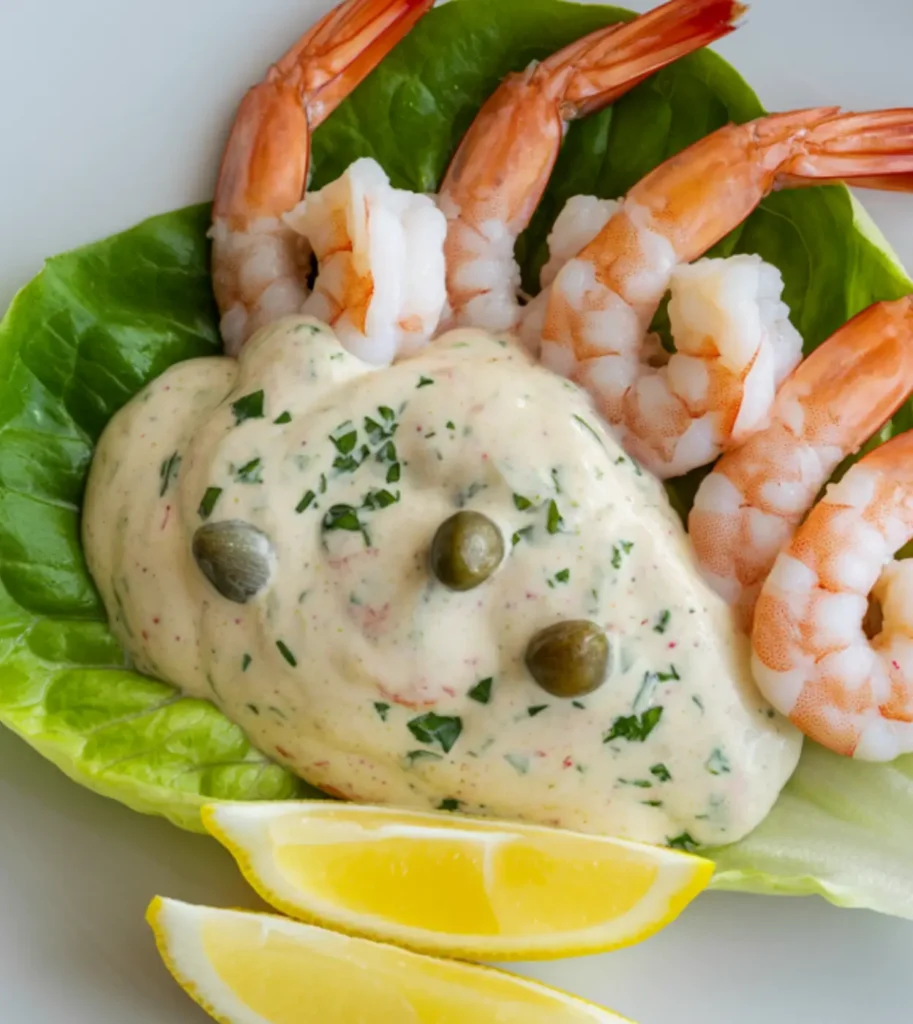
Top Tips for Perfecting Shrimp Remoulade
Tip #1: Master the Shrimp Cooking Technique
The foundation of exceptional Shrimp Remoulade begins with perfectly cooked shrimp:
- Size matters: Choose large shrimp (21-25 count per pound) for the ideal texture and presentation. Smaller shrimp can overcook quickly, while jumbo shrimp may remain somewhat tough.
- The ice bath is non-negotiable: Immediately cooling the shrimp stops the cooking process precisely when desired. Skipping this step results in overcooked, rubbery shrimp.
- Visual cues are more reliable than timing: Properly cooked shrimp should be pink with red tails and just curled into a “C” shape. If they curl into a tight “O” shape, they’re overcooked.
- Pat completely dry: Excess moisture dilutes the remoulade sauce and prevents proper adhesion. Take the time to thoroughly dry the shrimp with paper towels.
- Shell-on poaching option: For even more flavor, consider poaching with shells on, then peeling after cooling. This provides additional shrimp flavor in the meat, though it’s slightly more work.
Tip #2: Develop Depth in Your Remoulade Sauce
The complex flavor of authentic remoulade requires attention to detail:
- Creole vs. white remoulade: This recipe features Creole-style remoulade with its characteristic reddish-orange color. For a white remoulade, omit the ketchup and paprika and double the lemon juice.
- Ingredient hierarchy: Start with the base (mayonnaise) and add ingredients in order of volume to ensure proper integration and prevent clumping.
- Proper prep is essential: Be sure to finely mince the vegetables and herbs—large pieces can throw off the texture and keep the flavors from blending smoothly.
- Time is your friend: While the sauce can be used immediately, its flavor improves dramatically after 4-24 hours of refrigeration. Make it a day ahead for the best results.
- Temperature matters for serving: Remove the remoulade from the refrigerator 15-20 minutes before serving—cold temperatures mute flavors, and the sauce’s complexity shines at cool rather than cold temperatures.
Tip #3: Adjust for Personal Preference and Ingredient Availability
Authentic flavor doesn’t have to mean inflexible:
- Heat level customization: The cayenne and hot sauce can be adjusted up or down based on your preference. Start with less if uncertain—you can always add more.
- Creole mustard substitute: If you can’t find Creole mustard, whole grain mustard mixed with a touch of regular prepared mustard makes a good substitute. Dijon can work in a pinch but offers a different flavor profile.
- Herbaceous options: Traditional recipes vary in herb usage—some use only parsley, while others include tarragon, thyme, or chervil. Feel free to adjust the herb profile based on availability and preference.
- Textural variables: For a smoother remoulade, process the vegetables and herbs in a food processor before adding to the sauce. For more texture, hand-chop as directed in the recipe.
- Make it your own: Some New Orleans families add finely chopped hard-boiled egg or dill pickle to their remoulade. These variations are perfectly acceptable.
Tip #4: Presentation Enhancements for Maximum Impact
Visual appeal elevates the entire experience:
- Color contrast is key: The vibrant orangey-pink remoulade looks striking against green lettuce leaves. Consider the plate color as well—white plates make the colors pop.
- Serving temperature gradient: While the dish should be properly chilled for food safety, flavors are more pronounced when not ice-cold. Remove from refrigeration about 15 minutes before serving.
- Individual versus family-style: For elegant dinner parties, individual plating creates a more refined presentation. For casual gatherings, a large platter allows for dramatic presentation.
- Garnish with purpose: Each garnish should be both beautiful and functional—lemon wedges provide both color and a fresh squeeze of juice, while parsley adds color and a fresh herbal note.
- Edible flowers option: For special occasions, consider edible flowers like pansies or nasturtiums for an elegant garnish that elevates the presentation.
Tip #5: Make-Ahead Strategies for Stress-Free Entertaining
Proper planning makes this impressive dish surprisingly easy to execute:
- Component separation: The sauce and shrimp can be prepared separately up to two days in advance, then combined shortly before serving.
- Sauce development: The remoulade sauce actually improves with 1-2 days of refrigeration as the flavors meld and develop complexity.
- Final assembly timing: Combine the sauce and shrimp at least 30 minutes before serving to allow flavor absorption, but not more than 8 hours ahead to maintain optimal shrimp texture.
- Lettuce preparation: Wash and dry lettuce leaves up to 24 hours ahead, storing between damp (not wet) paper towels in an airtight container in the refrigerator.
- Garnish cutting: Prepare garnishes up to 4 hours ahead, storing herbs in damp paper towels and lemon wedges in an airtight container in the refrigerator.
Storing and Reheating Tips
While Shrimp Remoulade is best enjoyed fresh, proper storage can maintain quality for later enjoyment:
Storage Guidelines:
- Complete dish: Shrimp remoulade can be refrigerated in an airtight container for up to 2 days. After this point, the texture of the shrimp begins to deteriorate, though it remains safe to eat for an additional day.
- Remoulade sauce only: The sauce alone will keep well in the refrigerator for up to 5 days in an airtight container. This makes it an excellent make-ahead component.
- Cooked shrimp only: Plain poached shrimp (without sauce) can be stored in an airtight container in the refrigerator for up to 3 days.
Note About “Reheating”:
Shrimp Remoulade is traditionally served chilled or at cool room temperature, not heated. Heating the sauce can cause separation and will fundamentally change the character of the dish. Therefore, traditional reheating is not recommended. However, if you must serve it warm:
- Remove from refrigeration and allow to come to cool room temperature (about 30-45 minutes)
- Never microwave or apply direct heat to dressed shrimp
Repurposing Leftovers:
Rather than traditional reheating, consider these creative ways to use leftover Shrimp Remoulade:
- Shrimp Remoulade Sandwich: Spread remoulade sauce on a toasted baguette or brioche bun, then top with leftover shrimp remoulade and fresh lettuce and tomato.
- Remoulade Pasta Salad: Chop the leftover shrimp remoulade and toss with cooked, cooled pasta, additional fresh vegetables, and a bit of extra sauce if needed.
- Stuffed Avocados: Fill halved avocados with leftover shrimp remoulade for a quick, elegant lunch.
- Remoulade Dip: Chop the shrimp very finely and add extra sauce to create a spread for crackers or crudités.
- Creole Omelette: Chop the shrimp and fold into an omelette with a small amount of the sauce (warmed very gently) drizzled on top after cooking.
Freezing (Not Recommended):
Neither the completed dish nor its components freeze well. The mayonnaise-based sauce will separate upon thawing, and the texture of the shrimp will become unpleasantly rubbery. It’s best to make only what you plan to consume within the recommended refrigeration timeframe.
Food Safety Reminder:
Seafood dishes are particularly susceptible to bacterial growth. Never leave Shrimp Remoulade at room temperature for more than 2 hours (or 1 hour if the ambient temperature is above 90°F). Always store promptly in the refrigerator in a sealed container.
By following these detailed instructions and expert tips, you’ll create an authentic Shrimp Remoulade that captures the bold, complex flavors of New Orleans cuisine. This impressive dish strikes the perfect balance between sophisticated and approachable, making it ideal for everything from casual family meals to elegant dinner parties. The vibrant colors, contrasting textures, and harmonious flavor combination create a sensory experience that will transport you straight to the French Quarter with every bite.
Shrimp Remoulade: 5 Steps to a Bold Creole Classic
Cuisine: Creole / Southern AmericanDifficulty: Easy to Moderate4
servings30
minutes12
minutes375–450
kcalShrimp Remoulade is a bold and refreshing Louisiana-style dish featuring tender poached shrimp served over crisp lettuce and draped in a creamy, zesty remoulade sauce packed with Creole mustard, horseradish, herbs, and spices. It’s a perfect starter or light main course bursting with Southern flavor and coastal charm.
Ingredients
2 pounds large shrimp (21-25 count), peeled and deveined, tails left on
2 tablespoons Old Bay seasoning
1 tablespoon kosher salt
2 lemons, one quartered and one for juice
1 yellow onion, quartered
3 cloves garlic, smashed
2 bay leaves
1 tablespoon black peppercorns
1½ cups good-quality mayonnaise
¼ cup Creole mustard (substitute whole grain mustard if unavailable)
2 tablespoons prepared horseradish
2 tablespoons fresh lemon juice
2 tablespoons hot sauce (preferably Crystal or Louisiana-style)
2 tablespoons ketchup
1 tablespoon Worcestershire sauce
3 cloves garlic, very finely minced
2 tablespoons capers, rinsed, drained and chopped
2 tablespoons fresh flat-leaf parsley, finely chopped
2 tablespoons green onions, finely chopped (green parts only)
1 tablespoon celery, very finely diced
1 tablespoon fresh tarragon, finely chopped (or 1 teaspoon dried)
1 teaspoon paprika (preferably sweet Hungarian)
½ teaspoon cayenne pepper (adjust to taste)
½ teaspoon freshly ground black pepper
½ teaspoon kosher salt
1 head Bibb or Boston lettuce leaves, washed and dried
2 tablespoons chopped fresh parsley for garnish
Lemon wedges
Optional: cherry tomatoes for garnish
Directions
- Poach the Shrimp
In a large pot, bring water to a boil with aromatics like onion, garlic, lemon, bay leaves, peppercorns, Old Bay, and salt. Simmer for 5 minutes to infuse. Prepare an ice bath on the side. Add the shrimp to the boiling liquid and cook just until pink and slightly curled, about 2–3 minutes. Immediately transfer them to the ice bath to stop cooking. Once cooled, drain and pat the shrimp dry completely. - Make the Remoulade Sauce
In a bowl, whisk together mayonnaise, Creole mustard, horseradish, lemon juice, hot sauce, ketchup, and Worcestershire. Stir in garlic, capers, parsley, green onions, celery, and tarragon. Season with paprika, cayenne, black pepper, and salt. Adjust flavor to taste, then cover and chill the sauce for at least 1 hour (or overnight) to let the flavors develop. - Combine Shrimp and Sauce
Remove the chilled sauce from the fridge and stir. In a large bowl, gently fold two-thirds of the remoulade into the cooled shrimp until evenly coated. Be careful not to break the shrimp. Cover and chill for 30 more minutes so the shrimp absorb the flavors. Reserve the remaining sauce for serving. - Prep the Lettuce Base
Right before serving, wash and dry the Bibb or Boston lettuce thoroughly. Arrange the leaves on individual plates or a large platter to form a soft bed for the shrimp. Dry lettuce is key to avoiding watery sauce when plating. - Plate and Serve
Let the shrimp sit at room temp for 15–20 minutes before serving. Arrange shrimp over the lettuce—either plated individually or in a mound on a platter. Drizzle with extra remoulade or serve it on the side. Garnish with chopped parsley, lemon wedges, and cherry tomatoes if desired. Serve chilled and enjoy!
Notes
- Shrimp Remoulade is a classic cold appetizer from Louisiana, often seen on menus in New Orleans. The key to its flavor lies in the balance of tangy, spicy, and herbaceous notes in the sauce, which complements the sweetness of the shrimp perfectly. For best results, chill both the shrimp and the remoulade before serving. The Bibb lettuce adds crunch and elegance, while lemon wedges and optional cherry tomatoes brighten the plate.

